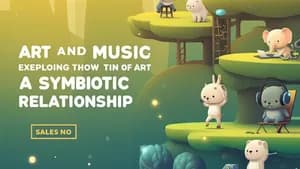Introduction: Seeing the Sound, Hearing the Sight
Have you ever listened to a piece of music and felt a strong visual image come to mind? Perhaps a swirling vortex of color for a dramatic symphony, or sharp, geometric shapes for a minimalist composition? This inherent connection between music and visual art, a phenomenon sometimes called synesthesia, has fascinated artists and thinkers for centuries. This article explores how artists have translated the abstract language of music into visual form, showcasing the incredible creative possibilities that arise when we blend these two powerful art forms. We'll delve into how you can explore these connections yourself, enhancing your understanding and appreciation of both music and art. I've witnessed firsthand how interdisciplinary learning boosts a student's overall comprehension; combining seemingly disparate subjects unlocks surprising insights.
Kandinsky and the Birth of Abstract Expressionism
Wassily Kandinsky, a pioneer of abstract art, is a prime example of an artist deeply influenced by music. His paintings are a vibrant testament to his belief in the intrinsic connection between color, form, and sound. Kandinsky experienced synesthesia, a neurological phenomenon where stimulation of one sense triggers another. For him, musical notes and chords evoked specific colors and shapes, which he then translated onto canvas. Consider his work Composition VIII – the dynamism and energy of the composition directly mirrors the powerful emotional impact of a symphony.
To understand Kandinsky's work, you can try a simple exercise: listen to a piece of classical music – a piano sonata, perhaps – and as you listen, try to visualize the music's form and emotion. What colors would you use to represent the different sections? What shapes would best capture the mood? Sketching your impressions is a fantastic way to bridge the gap between auditory and visual perception, and a great opportunity for creative expression. By actively engaging with music in a visual context, you develop deeper understanding of both.
Minimalism and Geometry: Music's Visual Simplicity
Minimalist composers like Philip Glass and Terry Riley created music characterized by repetitive structures and simple melodic lines. These compositions often lend themselves beautifully to visual representation through geometric shapes and patterns. Think of the repetitive, layered structures in Glass's Einstein on the Beach: the visual equivalent could be a series of stacked squares or overlapping circles, each representing a musical phrase, gradually building in complexity. The minimalist aesthetic, with its emphasis on reduction and repetition, is easily translated into visually minimalist art forms.
For a practical activity, try listening to a minimalist piece and then creating a geometric design based on its structure. You can use different shapes, colors, and sizes to represent the variation in tempo, dynamics, and melodic lines. This exercise helps you analyze musical structure in a new way. The process of translating auditory information to a visual medium challenges you to think critically about the fundamental building blocks of both music and visual design. Don't be afraid to experiment; the goal is to explore the relationship between sound and image.
Beyond the Canvas: Expanding Visual Representations
The visualization of music isn't limited to paintings; it extends to various mediums. Consider music videos, which are a powerful blend of sight and sound. Directors use visual elements like color, movement, and editing to enhance and complement the music. Think about how a fast-paced rock song might be accompanied by rapidly changing visuals, whereas a melancholic ballad might use slower, more deliberate imagery. Animation, particularly abstract animation, is another compelling way of translating musical ideas visually. The possibilities are truly endless.
For students, analyzing music videos and animated films is a great way to understand how visual artists interpret and respond to music. Pay close attention to the relationship between the music and the visual elements. How does the director use visuals to reinforce or contrast with the mood and message of the music? Documenting your observations in a written analysis can hone your critical thinking skills and improve your understanding of visual communication. This method is particularly useful when discussing and comparing different video styles for the same song.
Creating Your Own Visual Music: A Practical Guide
You don't need to be a professional artist to explore the visual language of music. Start with simple exercises: listen to a piece of music and sketch what comes to mind; use different colors to represent different emotions or instruments; build a collage using textures and materials that evoke the sounds you hear. Experiment with different mediums – painting, drawing, sculpting, digital art – and let your creativity flow. There are no right or wrong answers; the process is about exploration and discovery.
Remember to actively listen to the music. Pay attention to its tempo, rhythm, melody, harmony, and dynamics. How do these elements make you feel? What colors, shapes, or textures do they suggest? Keep a journal to record your observations and reflections. This documentation will help you develop your own unique visual vocabulary for expressing musical ideas. It is also a valuable learning tool for reflecting on your creative process. The act of reflecting on the creative process is as valuable as the final product itself.
Conclusion: A Symphony of Sight and Sound
The intersection of music and visual art offers a rich and rewarding field of exploration for students and enthusiasts alike. By understanding how artists have visually represented abstract musical concepts, you can deepen your appreciation of both art forms. Through active listening and creative experimentation, you can develop your own unique way of seeing the sound and hearing the sight. Embrace the process of discovery, enjoy the journey, and allow your creativity to flourish. I've seen countless students transform their understanding of art and music through interdisciplinary approaches; your own creative journey may surprise you with its insights and rewarding experiences.

